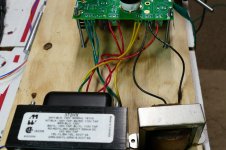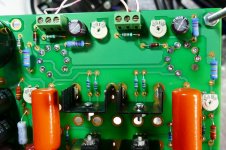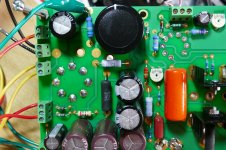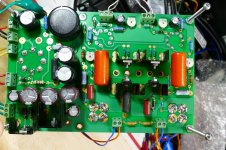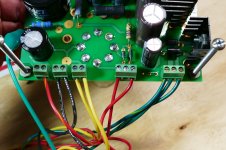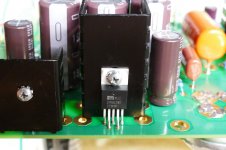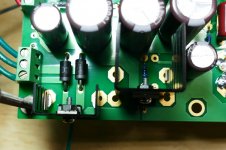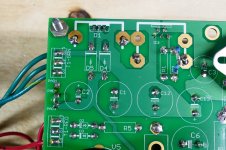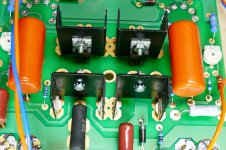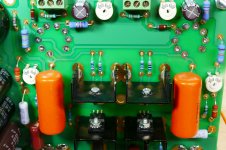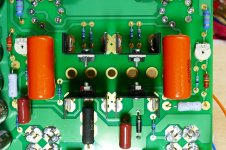Hi George
I bought two of your SE boards last fall, figuring I would screw up the first one. I didn't screw it up totally but it does have some hum that I can't get rid of. Was going to rebuild with the second board with all new resistors, caps etc. and use existing tubes and transformers. Now I think I will order your new board and build that up. I just send Paypal to your web site, right?
I would like to isolate the power transformer away from the rest of the amp on a seperate chassis. Do you have any suggestions for a safe way to do that and what kind of wire and insulation I could use?
Is there a current updated parts list that I could down load and start ordering parts?
Looking forward to the new board.
I bought two of your SE boards last fall, figuring I would screw up the first one. I didn't screw it up totally but it does have some hum that I can't get rid of. Was going to rebuild with the second board with all new resistors, caps etc. and use existing tubes and transformers. Now I think I will order your new board and build that up. I just send Paypal to your web site, right?
I would like to isolate the power transformer away from the rest of the amp on a seperate chassis. Do you have any suggestions for a safe way to do that and what kind of wire and insulation I could use?
Is there a current updated parts list that I could down load and start ordering parts?
Looking forward to the new board.
I built a TSE with 300B tubes. I was struggling with keeping things cool. Finally I gave in and moved all heat producing components off board, mounted them on massive heat sinks (from HAM fests for pennies) and wired connections back to the board. I was expecting hum and other problems but amp works beautifully with zero hum. Hopefully will post some pictures of the innards of my amp. Regarding Sharp regulator, my amp is working fine but just to stock up I was able to order 10 sharp regulators from Jotrin Electronics in Singapore. Price was right about $2.85 per piece. If anyone absolutely needs a regulator just contact me and I would be happy to send you one without charge. I would like to hold onto at least 5 for myself though 🙂The TSE was designed with 45's in mind. <snip>
OK, I believe this is the correct final BOM for the TSE-II. I ordered enough parts to make 4 boards, and construction should commence when they arrive. That should be somewhere in the middle of next week. There are a few minor changes since I last posted, and a whole page of notes gathered from building 3 different versions of this board. As of now I have only built one of the production boards. 11 have been sold so far and some people have already started building and have asked a few questions. I hope the notes answer them all.
I did manage to scare myself and my wife pretty good last night with some fireworks. The dangling volume pot touched one of the heat sinks when I flipped the board over to set the bias. Lots of sparks occurred since B+ was sparked directly to ground, and as before I had the Variac cranked up all the way......That low ESR cap I specified for C5 can blow some chunks out of a heat sink, but the old Sovtek rectifier tube shrugged it off, and the amp still works.......insulators are now specified for the CCS chips.
These files were updated this morning (5-26). A note was added concerning R4 and the optional choke. There were some email questions about the connectors for transformer, choke, and supplemental power supply cap. These were adopted from the SSE which was designed after the original TSE. The triode mode wiring diagrams for SSE apply to the TSE-II board, except for the heater windings. As with the SSE, if the 5 volt winding has a CT, DO NOT connect it to anything. The 6.3 volt winding connects to the board via the T1-GRN connector as in the SSE, except that the CT (usually green-yellow) must go to the terminal closest to the FRONT of the board, and the ends (usually green) must go to the center and rear terminals. Make NO EXTERNAL CONNECTIONS to the CT or any other 6.3 volt wire. Grounding the CT on a 300B amp will blow stuff up!
I have started a build notes document, and will post it ASAP, probably tomorrow. More build information will come with user questions, and as I build some boards and amps. It will take some time for all of this to be distilled into a form for the web site.
EDIT: the BOM and notes have been edited to include current AES part numbers for the tube sockets. The usual big parts distributors do NOT carry tube sockets. I usually get mine from Stan at ESRC, but he is out of the 4 pin sockets at the moment. I haven't used the AES parts in a while, so I ordrered some and will verify proper fitment when they arrive. The dimensions on the drawings match my parts, so these are low risk. AES = Antique Electronic Supply
NOTE...The A couple of inconsistancies were found in the BOM that was previously posted here. They were simple things line the letters IC used on the board VS U on the BOM, no part numbers were changed!
In order to avoid having two or more different versions of the BOM scattered throughout this thread, I have put the latest BOM in POST #1. All new BOM updates and build info will go into POST #1 so that it is easy to find.
I did manage to scare myself and my wife pretty good last night with some fireworks. The dangling volume pot touched one of the heat sinks when I flipped the board over to set the bias. Lots of sparks occurred since B+ was sparked directly to ground, and as before I had the Variac cranked up all the way......That low ESR cap I specified for C5 can blow some chunks out of a heat sink, but the old Sovtek rectifier tube shrugged it off, and the amp still works.......insulators are now specified for the CCS chips.
These files were updated this morning (5-26). A note was added concerning R4 and the optional choke. There were some email questions about the connectors for transformer, choke, and supplemental power supply cap. These were adopted from the SSE which was designed after the original TSE. The triode mode wiring diagrams for SSE apply to the TSE-II board, except for the heater windings. As with the SSE, if the 5 volt winding has a CT, DO NOT connect it to anything. The 6.3 volt winding connects to the board via the T1-GRN connector as in the SSE, except that the CT (usually green-yellow) must go to the terminal closest to the FRONT of the board, and the ends (usually green) must go to the center and rear terminals. Make NO EXTERNAL CONNECTIONS to the CT or any other 6.3 volt wire. Grounding the CT on a 300B amp will blow stuff up!
I have started a build notes document, and will post it ASAP, probably tomorrow. More build information will come with user questions, and as I build some boards and amps. It will take some time for all of this to be distilled into a form for the web site.
EDIT: the BOM and notes have been edited to include current AES part numbers for the tube sockets. The usual big parts distributors do NOT carry tube sockets. I usually get mine from Stan at ESRC, but he is out of the 4 pin sockets at the moment. I haven't used the AES parts in a while, so I ordrered some and will verify proper fitment when they arrive. The dimensions on the drawings match my parts, so these are low risk. AES = Antique Electronic Supply
NOTE...The A couple of inconsistancies were found in the BOM that was previously posted here. They were simple things line the letters IC used on the board VS U on the BOM, no part numbers were changed!
In order to avoid having two or more different versions of the BOM scattered throughout this thread, I have put the latest BOM in POST #1. All new BOM updates and build info will go into POST #1 so that it is easy to find.
Last edited:
Here are some pictures of my working 2A3 board. It has also been used with 45's, but the power transformer must be changed. 45's don't like 400 volts! The Chinese 2A3's don't seem to care and give me a bit over 4 WPC.
Some of my parts are not exactly correct. I used what I had where it doesn't matter. I see a 6.2 K carbon comp where a 4.7K is specified. Anything from 4.7K to 10K will work fine. I also used 1/2 watt 620 ohm resistors where 1/4 watt is called for. There are probably a few more such cases, but the correct parts are on order, and will be used for the assembly manual photos.
The green clip lead is the voltmeter ground. I was taking voltage readings while twisting the Variac the other night when the volume pot hit the heat sink.
Some of my parts are not exactly correct. I used what I had where it doesn't matter. I see a 6.2 K carbon comp where a 4.7K is specified. Anything from 4.7K to 10K will work fine. I also used 1/2 watt 620 ohm resistors where 1/4 watt is called for. There are probably a few more such cases, but the correct parts are on order, and will be used for the assembly manual photos.
The green clip lead is the voltmeter ground. I was taking voltage readings while twisting the Variac the other night when the volume pot hit the heat sink.
Attachments
I also used 1/2 watt 620 ohm resistors where 1/4 watt is called for. There are probably a few more such cases, but the correct parts are on order, and will be used for the assembly manual photos.
Is there an advantage to using 1/4 watt resistors if one already has 1/2 watt resistors in the appropriate values?
If your resistors fit the board, use them. The parts dissipate 50 milliwatts worse case, usually about 20, so that any 620 ohm resistor will work.
My 1/2 watt parts are a little big for the board, but work. I just got a few of the "correct" parts to be used to make pictures for a build manual similar to the SSE and original TSE.
My 1/2 watt parts are a little big for the board, but work. I just got a few of the "correct" parts to be used to make pictures for a build manual similar to the SSE and original TSE.
A few more pictures showing the heat sink detail when mounted on the under side of the board.
I have temporarily moved R2 and the jumper to the top of the board for easy voltage changes. It can be mounted there permanently if it does not touch the chassis plate. I still don't have any 300 ohm resistors, so mine is a 100 ohm and a 200 ohm in series.
I have 300B's in the board now, and will be doing some experiments with higher voltages in the near future.....first stop 5.5 volt 307A's wired as triodes. They worked nice in the older boards. I should have some 811A's somewhere, but haven't seen them in years......maybe they didn't make the big move.
D1 is reversible and can be mounted on either side of the heat sink. IC3 is not. It comes with the leads flat, and they must be formed differently depending on which side you mount them on.
It is helpful if the parts are mounted on the heat sinks with the screw heads facing the edge of the board. This makes it possible to change a part without removing the heat sink.
The heat sinks have tabs that fit into holes in the board. If the amp will be subject to vibration or rough handling, these tabs should be soldered into the board. I usually will tack solder one or both pins so that the heat sink won't fall out during assembly. Some builders don't solder them at all.
I have temporarily moved R2 and the jumper to the top of the board for easy voltage changes. It can be mounted there permanently if it does not touch the chassis plate. I still don't have any 300 ohm resistors, so mine is a 100 ohm and a 200 ohm in series.
I have 300B's in the board now, and will be doing some experiments with higher voltages in the near future.....first stop 5.5 volt 307A's wired as triodes. They worked nice in the older boards. I should have some 811A's somewhere, but haven't seen them in years......maybe they didn't make the big move.
D1 is reversible and can be mounted on either side of the heat sink. IC3 is not. It comes with the leads flat, and they must be formed differently depending on which side you mount them on.
It is helpful if the parts are mounted on the heat sinks with the screw heads facing the edge of the board. This makes it possible to change a part without removing the heat sink.
The heat sinks have tabs that fit into holes in the board. If the amp will be subject to vibration or rough handling, these tabs should be soldered into the board. I usually will tack solder one or both pins so that the heat sink won't fall out during assembly. Some builders don't solder them at all.
Attachments
Call me stupid, but is there any way to order a TSEII board without actually creating a PayPal account? I'm used to seeing a "Pay as Guest" button when purchasing through most websites using the service, but it doesn't seem to be a "feature" of the site itself. I used to have an account, but closed it after my card info was given to an outfit called "Unlicensed Cellphone Kings".
As you've probably deduced, I'm really loath to opening another PayPal account.
As you've probably deduced, I'm really loath to opening another PayPal account.
The old fashioned way still works. Send me a money order for $48. The mailing address is:
Tubelab Inc.
73 Bottom Ln
Moundsville WV 26041
Make sure that your mailing address is in there somewhere, or put it in an email or PM.
Tubelab Inc.
73 Bottom Ln
Moundsville WV 26041
Make sure that your mailing address is in there somewhere, or put it in an email or PM.
I have edited post #244 to have the most current BOM and notes. The only changes are the part numbers for the tube sockets.
These are now the current AES part numbers for the tube sockets. The previously posted numbers were 10 years old, and dead.
The usual big parts distributors do NOT carry tube sockets.
I usually get mine from Stan at ESRC, but he is out of the 4 pin sockets at the moment. I haven't used the AES parts in a while, so I ordered some and will verify proper fitment when they arrive. The dimensions on the drawings match my parts, so these are low risk. AES = Antique Electronic Supply
These are now the current AES part numbers for the tube sockets. The previously posted numbers were 10 years old, and dead.
The usual big parts distributors do NOT carry tube sockets.
I usually get mine from Stan at ESRC, but he is out of the 4 pin sockets at the moment. I haven't used the AES parts in a while, so I ordered some and will verify proper fitment when they arrive. The dimensions on the drawings match my parts, so these are low risk. AES = Antique Electronic Supply
Do you still take PayPal
Yes, Paypal works the email address is tech at tubelab dot com.
I don't post my email address in complete form to avoid it being picked up by spambots. You should be able to put it back together.
The TSE-II board is $40 due to it's larger size and gold finish. Shipping in the US is still $8 and international is $15.
Thanks, George. Glad to know you'll go the USPO money order route. I'm sure I'm not the only one, either.
I didn't mean to sound obtuse, but my brush with credit card fraudsters was a real pain to resolve - like I had to start by convincing them that I wasn't the crook. It didn't cost me money in the end, but the time I spent convinced me that having a rarely-used account like that was just asking for trouble. Like they say, "Fool me once..."
And thanks also for updating those tube socket numbers. I was getting a bit puzzled by the old ones. 🙂
I didn't mean to sound obtuse, but my brush with credit card fraudsters was a real pain to resolve - like I had to start by convincing them that I wasn't the crook. It didn't cost me money in the end, but the time I spent convinced me that having a rarely-used account like that was just asking for trouble. Like they say, "Fool me once..."
And thanks also for updating those tube socket numbers. I was getting a bit puzzled by the old ones. 🙂
I'm sure I'm not the only one, either.
I get one to two money orders a year. It means a trip to the bank, but no Paypal fees.
Most people do use Paypal. The story is that it is "safer." I have used Paypal since it started up and had no security issues. Their refund policy makes it impossible to sell rare tubes and other valuable items, and I learned which countries NOT to ship to.
like I had to start by convincing them that I wasn't the crook.
I have had cards cloned. Usually the card company figures it out before me, freezes the card and sends me a text or email. I stopped for gas in Georgia on a trip to Florida last year. I had only traveled about 50 miles after the gas stop when someone tried to buy $200 worth of diesel fuel in Arizona on my card. Obviously even a rocket can't move that fast, so the card was killed. The card company didn't even want to know where the gas station was.....
Later last year my Tubelab credit card was cloned....OK, I use it at Mouser, Digikey, the USPS, and maybe rarely a few small electronics distributors. It's a short list. Someone ordered $100 worth of pizza and later bought a bunch (over $1K) of clothing online. The bank did NOT catch this. I found it when I got my statement. There should be an obvious trail here, but the bank said it was me. UH, look at my purchase history for say 10 YEARS, what do I buy. Where was the pizza place? Where was the clothing sent? Send the cops there....They would not answer those questions. Meanwhile some parts orders that I DID make were refused.
Yeah, the credit card thing could be better policed, but the banks don't seem to care.
Banks and credit card companies don't need to care anymore because of deregulation and the fact that most governmental consumer protections have been killed by Trump and his cronies.
Check this blog out. Mr. Wallum goes into great detail about the history of the deregulation of corporate America. Looted Nation Looted Nation
- Home
- More Vendors...
- Tubelab
- After a 14 year run, the TSE must DIE!
